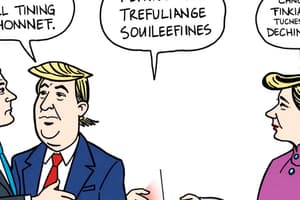Podcast
Questions and Answers
What is agenda setting?
What is agenda setting?
Agenda setting is the ability of the media, through repeated news coverage, to raise the importance of an issue in the public's mind. Mainstream media coverage of an issue can elevate its importance to the public.
What is agenda?
What is agenda?
An agenda is a list of items in order of importance, with the most important at the top.
In the Chapel Hill study, what factor did researchers find strongly correlated with the public's perception of important issues?
In the Chapel Hill study, what factor did researchers find strongly correlated with the public's perception of important issues?
- Media coverage of issues (correct)
- Political campaign contributions
- Public opinion
- Government policy
What is a weakness of the Chapel Hill study?
What is a weakness of the Chapel Hill study?
Name the study that first systematically examined the agenda-setting hypothesis.
Name the study that first systematically examined the agenda-setting hypothesis.
What is the key focus of agenda-setting theory in terms of media influence?
What is the key focus of agenda-setting theory in terms of media influence?
Agenda-setting only applies to political issues.
Agenda-setting only applies to political issues.
Which of the following is NOT a factor that affects the media agenda?
Which of the following is NOT a factor that affects the media agenda?
Provide one type of influence from outside media organizations, as mentioned in the text.
Provide one type of influence from outside media organizations, as mentioned in the text.
Describe one way that media routines can influence the agenda.
Describe one way that media routines can influence the agenda.
What is intermedia agenda setting?
What is intermedia agenda setting?
Give an example of how an individual media worker's background could influence their approach to covering news.
Give an example of how an individual media worker's background could influence their approach to covering news.
Which of the following is an example of an organizational influence that affects the media agenda?
Which of the following is an example of an organizational influence that affects the media agenda?
Explain how the TikTok algorithm contributes to agenda setting.
Explain how the TikTok algorithm contributes to agenda setting.
Flashcards
What is an Agenda?
What is an Agenda?
A list of items in order of importance, with the most important at the top.
What is Agenda Setting?
What is Agenda Setting?
The media's ability to make certain issues more important in the public's mind through repeated news coverage.
War on Drugs Example
War on Drugs Example
The media coverage during the war on drugs, despite a decrease in drug use in reality, led people to believe the drug problem was increasing.
Crime Wave Example
Crime Wave Example
Signup and view all the flashcards
Chapel Hill Study
Chapel Hill Study
Signup and view all the flashcards
Chapel Hill Study Results
Chapel Hill Study Results
Signup and view all the flashcards
Chapel Hill Study Weakness
Chapel Hill Study Weakness
Signup and view all the flashcards
Media Agenda and Reality
Media Agenda and Reality
Signup and view all the flashcards
Media Agenda and Reality Data
Media Agenda and Reality Data
Signup and view all the flashcards
Media Agenda and Reality Results
Media Agenda and Reality Results
Signup and view all the flashcards
Media Agenda and Reality Discrepancy
Media Agenda and Reality Discrepancy
Signup and view all the flashcards
Media Agenda Setters
Media Agenda Setters
Signup and view all the flashcards
Intermedia Agenda Setting
Intermedia Agenda Setting
Signup and view all the flashcards
Intermedia Agenda Setting Example
Intermedia Agenda Setting Example
Signup and view all the flashcards
Signup and view all the flashcards
Study Notes
Agenda Setting
- Agenda setting is a media's ability to raise the importance of an issue in the public's mind through repeated news coverage.
- Mainstream media attention to an issue elevates its importance to the public.
- The public perceives issues based on the media's emphasis.
- A relationship exists between the media's agenda and the public's agenda.
- The correlation between the two agendas can be strong, indicating a high influence of the media on public perception.
Chapel Hill Study
- McCombs and Shaw conducted the first systematic study on agenda-setting.
- Their 1972 study examined how mass media influenced attitudes during a U.S. presidential election campaign.
- The study focused on "undecided" voters and analyzed the issues emphasized by the media.
- The study found a strong correlation between the media's agenda and the public's perception of important issues.
- The study's weakness was its inability to determine which agenda influenced the other.
Media Agenda and Reality
- The study focused on the 1970s, when several prominent issues emerged.
- G. Ray Funkhouser examined the relationship between news coverage, public perception, and real-world issues.
- Data was collected from local newspapers over three weeks.
- Real-world data came from U.S. statistical abstracts.
- Funkhouser's study showed a strong correlation between public ranking of an issue and the amount of media coverage it received.
- However, media coverage did not always accurately reflect the reality of these issues.
Who Sets the Agenda for the Media
- Agenda setting is influenced by several factors.
1. Intermedia Agenda Setting
- When elite media (e.g., New York Times) set the agenda, other media outlets often cover the same issues.
2. Individual Media Workers
- Media workers (e.g., reporters, editors) can influence the agenda based on their biases, backgrounds, and beliefs.
3. Media Routines
- Deadlines, space constraints, and reliance on official sources can shape the media agenda.
- Social media algorithms can influence what content is prioritized.
- Videos formatted for social media (e.g., 30-second reels) often get attention and are frequently shared.
4. Organizational Influences
- Media organizations strive for specific goals, including profit. This might lead to covering certain topics (e.g., news about advertisements) and neglecting others (e.g., corruption).
5. Influences from Outside Organizations
- Pressure groups, interest groups (e.g., anti-harassment groups in Egypt), and governments exert influence on media.
- Government pressure on platforms to censor content (e.g., TikTok removing reels supporting Hamas).
6. Society Ideology
- Societal values (e.g., beliefs in capitalism and democracy) influence the media's agenda, and vice-versa.
- Topics socially considered taboo may be avoided, depending on the country or society's values (e.g., nudity, mercy killing).
TikTok Algorithm
- The TikTok algorithm prioritizes content based on initial views, likes, comments, and shares, influencing popularity.
- The algorithm filters based on viewer interests and preferences, showing content tailored to each individual user.
Textbook Examples
- War on Drugs: Media coverage exaggerated the drug problem, creating a higher priority for public officials despite statistics showing a decline in the problem.
- Crime Wave: Media coverage, causing exaggerated fear, increased the perceived crime rate.
- These examples show how media can affect the public's understanding and response to events.
Studying That Suits You
Use AI to generate personalized quizzes and flashcards to suit your learning preferences.




